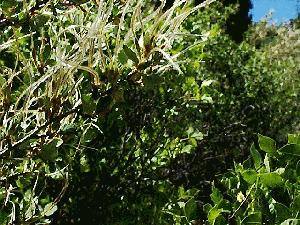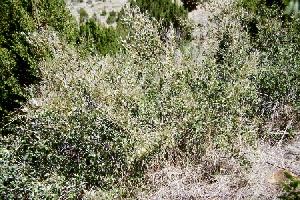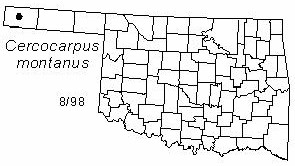

Shrub or small tree, to 4 m (12 ft) tall. Crown spreading. Bark gray to brown, fissured. Twigs gray to brown, stout, pubescent. Leaves alternate, simple, ovate, oval or obovate, 1.6-3.2 cm (0.6-1.25 in) long, about 2 cm (0.75 in) wide, lower surface glabrous to villous with appressed hairs, green to grayish green above, paler beneath; cuneate at base, acute to rounded at apex, margin with coarse ovate to triangular teeth; petioles about 8 mm (1/3 in) long, stipules adnate to petiole base, lanceolate to ovate, acute, brown, scarious. Flowers solitary or fascicled on short spurs, villous, styles terminal, exerted and plume-like; stamens 22-44; flowers appear from March to June. Fruits 0.8-1 cm (0.3-0.4 in) long, with persistent plumose style 4.5-6.4 cm (1.8-2.5 in) long.
Distribution: New Mexico west to Arizona, north to Wyoming and South Dakota. Rare in Oklahoma, restricted to northwest Cimarron County.
Habitat: dry rocky slopes.
Comments: Cercocarpus refers to plume-like tail on fruit; montanus refers to mountainous habitat.
Field identification: easily identified by the plume-like fruits and silvery leaves. Much taller than Apache plume (Fallugia paradoxa), which also occurs in northwest Cimarron County.
Wildlife uses: Mountain mahogany provides browse for deer and antelope.
NWI status: none
Distribution in Oklahoma: 
BACK
NEXT
RETURN TO INDEX
Last update: 9/9/99
 Go to Oklahoma Biological Survey Home Page
Go to Oklahoma Biological Survey Home Page
 Disclaimer
Disclaimer